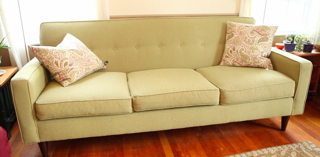
For most people, the only dangerous thing about your couch
is the risk of spending money on a nice piece of furniture, only to have your
cat shred it to pieces. But today a startling new peer reviewed study came out
in Environmental Science and Technology, showing that couches across America
contain high levels of toxic chemicals. Great coverage of the study can be read on the front page of the Chicago Tribune.
The study found that 85% of couches tested contained toxic or untested
flame-retardants. And the newer the couch, the more likely they were to contain
toxic chemicals. The use of flame-retardants has increased over the years and
now over 94% of new couches contain one or more of these toxic chemicals.
Here are some key findings:
- 85% of couches tested contained toxic or
untested flame retardant chemicals. - The flame-retardants are used heavily in the
foam, in some cases they made up 11% of the weight of the foam. - The toxic chemicals used in couches do not stay
in the couches – they migrate out into your household dust. - Toddlers and
children are at higher risk for exposure to toxic flame-retardants since they
play on the floor, creating small dust circles around them. Recent studies have also confirmed that people of color have higher rates of flame retardants in their bodies than their white counterparts. - 41% of the couches contained cancer-causing
“chlorinated tris,” also known as TDCPP, removed from baby pajamas in 1977. - Some of the chemicals found are linked to
cancer, harming the developing brain, hormone disruption and more.
The study comes off the heels of a long and well-done
investigative series by the Chicago Tribune on the chemical industry (the flame
retardant industry specifically) and their cynical attempts to keep these toxic
chemicals on the market, and in our homes.
So where can you buy a couch with out toxic flame-retardants?
It’s a natural first question when faced with information
such as this, but we need better laws, not better shopping lists. And therein lies
the solution to help get us out of this mess.
The reason toxic chemicals are ending up in our couches,
homes and children, is that the U.S. weak laws on toxic
chemicals. Our federal laws are failing to protect consumers and communities
from the harmful and routine exposure to toxic chemicals that are linked to
cancer and harming the developing brain.
A common sense solution is for Congress to pass the Safe
Chemicals Act, a bill introduced by the public health hero, Senator Frank
Lautenberg. His bill, would increase the safety of chemicals used in our
everyday products, protect vulnerable populations like the developing fetus,
pregnant women and “hot spot” communities.
Senator Lautenberg took on Big Tobacco and successfully banned
smoking on airplanes, if there is one champion to get the Safe Chemicals Act
passed, it is him. Please join us today in this quest to put limits on toxic
chemicals in our homes, we need your help!
What you can do:
Urge your Senator to pass the Safe Chemicals
Act
Take action today and join the movement today to help
limit the use of toxic chemicals in our couches and other consumer products!
Reduce Exposure to Dust
Since dust is the primary route of exposure
for these chemicals. Dusting frequently with a microfiber cloth (no need to use
dusting sprays!), a wet mop and frequently vacuuming with a HEPA filter will go
a long way to reduce your exposure. Studies have also shown that frequently
washing your hands with soap and water will also decrease exposure.
Contact the Manufacturers of Products in
Question
If you have a product in question, call the
manufacturer and ask if they use any flame retardant chemicals. If they are
using toxic flame-retardants, ask them to stop using them immediately. Also
consider using social media to ask companies to stop using flame retardants,
this can help shed light on both good and bad companies.
Act with Safer Chemicals, Healthy Families now!



